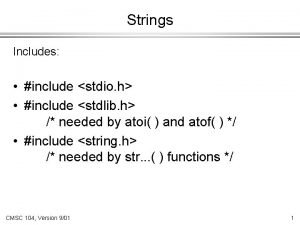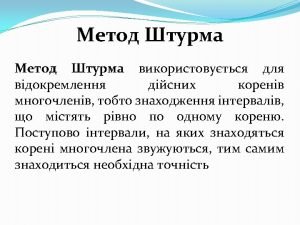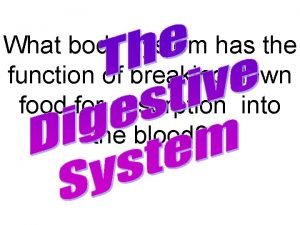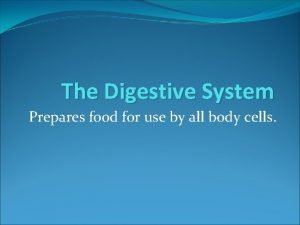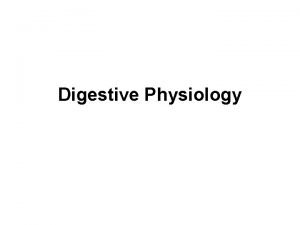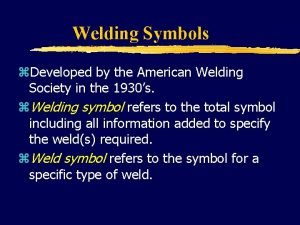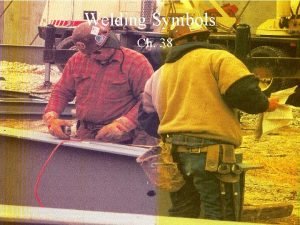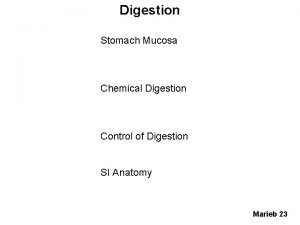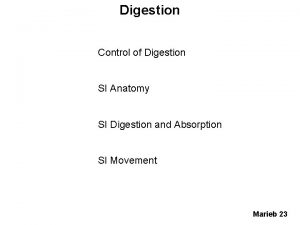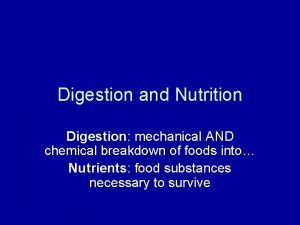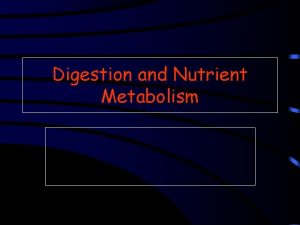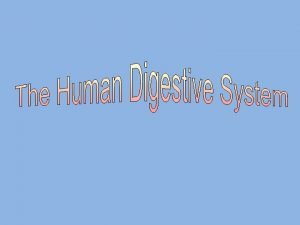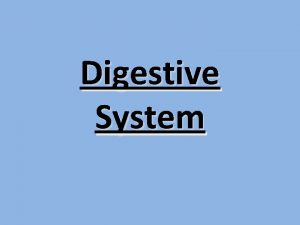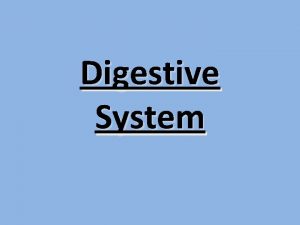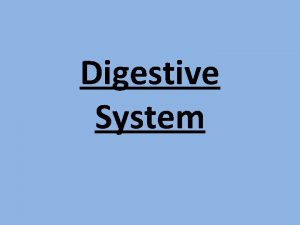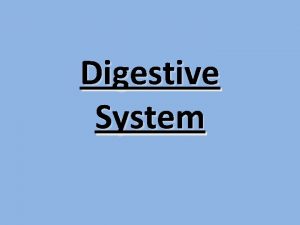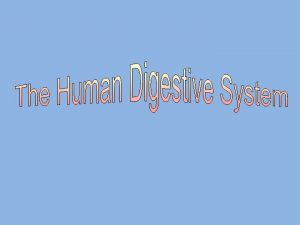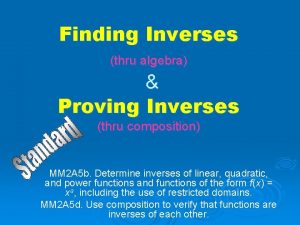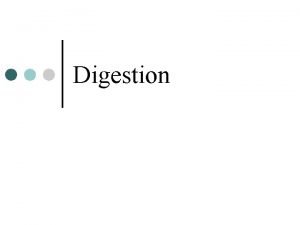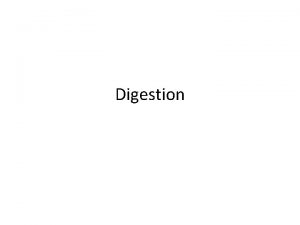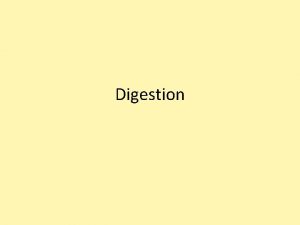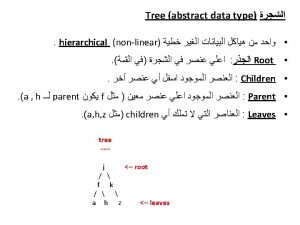Phases Include Digestion 1 Ingestionintake of food thru


























- Slides: 26


• Phases Include Digestion 1. Ingestion-intake of food thru mouth 2. Mechanical digestion-chewing and mixing food 3. Chemical Digestion-breaks food down into building blocks/monomers 4. Secretion-release of H 2 O, acids, enzymes 5. Absorption-movement into blood stream of organics, water, electrolytes, vitamins 6. Elimination (defecation)-form and remove feces 7. Defense-high acidity, enzyme action, macrophages in lymph nodes 8. Peristalsis-involuntary, sequential contractions of smooth muscle. Move food through the tract

Digestion • Types – Mechanical (physical) • Chew • Tear • Grind • Mash • Mix – Chemical • Enzymatic reactions to improve digestion of – Carbohydrates – Proteins – Lipids

Salivary Glands • Produces saliva – Contains enzymes that break carbs into monomers • Parotid • Submandibular • sublingual 2/14/2022 4

Mouth • Teeth mechanically break down food into small pieces. Tongue mixes food with saliva (contains amylase, which helps break down starch). Forms bolus • Epiglottis is a flap-like structure at the back of the throat that closes over the trachea preventing food from entering it.

Digestive System Organization • Gastrointestinal (Gl) tract – Tube within a tube – Direct link/path between organs – Structures • • Mouth Pharynx Esophagus Stomach Small intestine Large Intestine Rectum 6

Esophagus • Approximately 10” long • Functions include: 1. Secrete mucus 2. Moves food/bolus from the throat to the stomach using muscle movement called peristalsis • If acid from the stomach gets in here that’s heartburn. 3. Lower esophageal (cardiac) sphincter relaxes and food enters the stomach.

Stomach • J-shaped muscular bag that stores the food you eat, breaks it down into tiny pieces. • Mixes food with digestive juices that contain enzymes to break down proteins and lipids. • Hydrochloric Acid in the stomach kills bacteria. • Food found in the stomach is called chyme. • Chyme spends 1 -3 hours in stomach small intestine 8

Small Intestine • Small intestines are roughly 7 meters long • Lining of intestine walls has finger-like projections called villi, to increase surface area. • The villi are covered in microvilli which further increases surface area for absorption. 9

2/14/2022 10

Small Intestine • Nutrients from the food pass into the bloodstream through the small intestine walls. • Absorbs: – 80% ingested water – Vitamins – Minerals – Carbohydrates – Proteins – Lipids • Secretes digestive enzymes 11

Small intestine • Divided into three sections – Duodenum • C-shaped • About 10 inches long • Stimulates the release of secretions from pancreas into duodenum. – alkaline; mostly H 20 and sodium bicarbonate » Neutralizes acid in chyme 2/14/2022 12

Jejunum and ileum • Jejunum – Absorption of digested food 2/14/2022 • Ileum – Bile salts and vitamin B 12 absorption 13

• Chyme remains in small intestine for 1 to 6 hours cecum (first part of large intestine • Appendix extends from the cecum – Bacteria and indigestible material sometimes gets trapped here appendicitis. 14

Large Intestine • About 5 feet long • Accepts what small intestines don’t absorb • Rectum (short term storage which holds feces before it is expelled).

• Functions Large Intestine – Bacterial digestion • Ferment carbohydrates • Protein breakdown Absorbs more water – Concentrate wastes –

Large intestine-Colon • Four divisions of large intestine – Ascending colon – Transverse colon – Descending colon – Sigmoid colon • Indigestible material remains here 12 - 36 hours rectum anal canal defecation 2/14/2022 17

Accessory Organs • Not part of the path of food, but play a critical role. • Include: Liver, gall bladder, and pancreas

Liver • Directly affects digestion by producing bile that is dumped into duodenum – Bile helps digest fat • filters out toxins and waste including drugs and alcohol 19

Gall Bladder • Stores bile from the liver, releases it into the small intestine. • Required for fat digestion so enzymes can digest fats into building blocks. • Fatty diets can cause gallstones

Pancreas • Produces digestive enzymes to digest fats, carbohydrates and proteins • Regulates blood sugar by producing insulin

Fun Facts • HOW LONG ARE YOUR INTESTINES? At least 25 feet in an adult. Be glad you're not a full-grown horse -- their coiled-up intestines are 89 feet long! • Food drying up and hanging out in the large intestine can last 18 hours to 2 days! • In your lifetime, your digestive system may handle about 50 tons!!


On a sheet of paper, write the name of each colored organ: • • Green: Red: Pink: Brown: Purple: Green: Yellow:

How’d you do? • • Green: Esophagus Red: Stomach Pink: Small Intestine Brown: Large Intestine Purple: Liver Green: Gall Bladder Yellow: Pancreas Great Job!

References and Links • Your Digestive System and How It Works – Digestive system diagram comes from this site • The Real Deal on the Digestive System • Pancreas: Introduction and Index • Your Gross and Cool Body - Digestive System
 #include stdio.h #include stdlib.h #include string.h
#include stdio.h #include stdlib.h #include string.h #include stdio.h #include conio.h #include stdlib.h
#include stdio.h #include conio.h #include stdlib.h Saltine cracker digestion lab
Saltine cracker digestion lab Tears crushes and mashes food
Tears crushes and mashes food Intestinal phase of digestion
Intestinal phase of digestion Which type of diesel injection produces less noise
Which type of diesel injection produces less noise Pitch of weld symbol
Pitch of weld symbol Gsa fleet card driver id
Gsa fleet card driver id Types of holes
Types of holes Thru hole symbol
Thru hole symbol Seam weld symbols
Seam weld symbols Gsa fleet management
Gsa fleet management Gsa fleet card
Gsa fleet card Thru the lock forcible entry
Thru the lock forcible entry Gsa fleet drive thru
Gsa fleet drive thru Gsa fleet drive thru
Gsa fleet drive thru Include string
Include string Include iostream using namespace std
Include iostream using namespace std #include iostream #include cmath
#include iostream #include cmath Include time
Include time #include stdio.h
#include stdio.h
